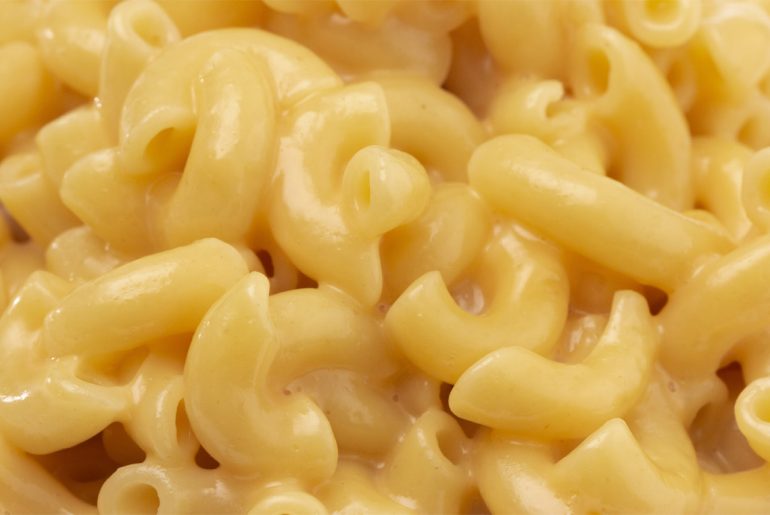Instant mac and cheese might pass the test for as a college dorm room quick fix, but everyone knows that nothing beats the homemade stuff. At its best, the real deal — made from scratch — can truly transcend you to a carb-loving comfort food heaven. Whether it’s baked into a crunchy-topped casserole or scooped straight from the stove top, the creamiest mac and cheese starts with the right cheese.
So what cheeses guarantee maximum creaminess? The main quality a cheese must have is meltability. It might seem obvious, but often times home cooks can lose sight of the end goal (And, admittedly, those fancy, sprawling cheese departments at the supermarket can have us wanting to experiment with all kinds of cheeses we don’t need). Plus, you want a cheese that isn’t going to separate into an oily, grainy mess.
So stay on task and when you head to the store. Here’s your fantastically delicious mac and cheese shopping guide to take to the market:
The best types of cheese for mac and cheese
For the creamiest, most delicious mac and cheese, use a blend. Try Gouda and Sharp cheddar, Brie and Gouda, or pretty much any combination of these perfect cheese choices.
Sharp cheddar
Origin: England
Made from: Cow’s milk
You might say sharp cheddar is the king of all melty cheese options. Its smooth flavor and classic taste make it an all-American all-around go-to for melting atop burgers, sandwiches, and mixing into mac and cheese. Sharp cheddar will give you the most familiar taste. Just remember to buy the block of cheese and not the pre-shredded. Pre-shredded has lost too much moisture by the time it makes it to your cheesy mac.
Gouda
Origin: Netherlands (Dutch)
Made from: Cow’s milk, some types may come from sheep’s or goat’s milk
Young Gouda is rich and mellow, while aged Gouda has a stronger flavor. Both melt beautifully and make for a merry bowl of mac and cheese. Used smoked Gouda if you’re looking to add bacon — you’ll love this combo. Gouda of any kind makes an easy upgrade for a slightly more sophisticated mac and cheese.
Gruyère
Origin: Switzerland
Made from: Cow’s milk
Gruyère is a hard cheese prized for its complex sweet and nutty flavors. Add a bit of depth to your burgers, grilled cheese, and of course, mac and cheese by using Gruyere.
Brie
Origin: Mostly from France
Made from: Cow’s milk, though some goat’s milk brie is out there, too
You fancy! Brie, the preferred cheese of dinner parties in the Western world, is also an excellent choice to melt over and coat your noodles. Its creamy texture is consistent, but its flavor ranges from mild to extremely nutty and tangy. It should be your cheese of choice if you’re looking to impress. Remove the rind first, and your elevated mac and cheese will be ready in no time.
Goat cheese
Origin: France if your cheese is labeled “chevre”
Made from: Cow’s milk. Just kidding! Goat’s milk, of course.
Zingy, flavorful goat’s cheese comes in many varieties and is a favorite of cheese lovers worldwide. Try adding goat’s cheese into another cheese for a deliciously unique melty blend.
Fontina
Origin: Italy (originally), Sweden, or Denmark
Made from: Cow’s milk
Fontina is easily identifiable by its red wax casing. Choose a mid-priced Fontina for an earthy, buttery flavor you’ll definitely reach for time and time again.
Havarti
Origin: Denmark
Made from: Cow’s milk
Frequently sold with herbs and spices blended in, like dill or jalapeño, Havarti can range from mild to strong, but its buttery flavor makes it a perfect pick for all your melty cheese needs.
Monterey Jack
Origin: United States (California)
Made from: Cow’s milk
If your perfect mac and cheese includes a little pizazz, pick Monterey Jack. It melts like a dream. Just remember, get the block. No pre-shredded stuff!
Cream cheese
Origin: United States (New York)
Made from: Cow’s milk
While we don’t recommend using cream cheese on its own, fresh cream cheese can add a smooth, decadent flavor when blended with another cheese. The USDA mandates that cream cheese be at least 33 percent fat, meaning it will help coat your noodles like no other.
What else you should know
Don’t choose just one cheese
A blend of cheeses will give you the dreamiest, creamiest mac and cheese imaginable.
Pick a perfect noodle
Shy away from long, skinny noodles or anything delicate. You want a robust noodle that can hold a lot of that delicious cheese sauce you’ve worked so hard for. Shells, campanelle, and the classic elbow macaroni will never lead you wrong.
Use plenty of cheese
If there is one crime you can make against mac and cheese it’s not using enough cheese. This is no time to hold back! Pasta should be swimming in a sea of delicious melty cheese sauce. Only add enough liquids, a little at a time, to encourage your sauce to smooth and stir easily. You want an amazing cheese sauce — not soup.
Also see, Pumpkin mac and cheese is perfect for fall.




